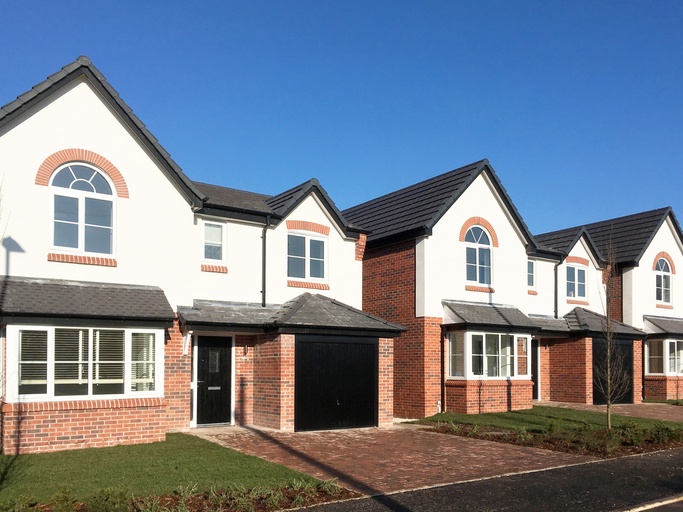Pros and cons of new build homes
When it comes to deciding whether to buy a new build or an older property you need to look at the pros and cons of new build versus an older property. There are advantages and disadvantages with both. You need to weigh up what is important to you, and which type of property ticks the most boxes on your ‘must-have’ list.

Here’s a rundown of the pros and cons of new build homes that have stood the test of time.
Pros and cons of new build homes
The number of new build homes in England has been falling in recent years with 239,300 new homes completed in the twelve months to June 2023 according to Energy Performance Certificate (EPC) data. This is the lowest level since 2017 (excluding the pandemic). Even so, new build homes are likely to be up for consideration when you are thinking about buying. So let’s take a look at the pros and cons of buying a brand new home straight from the developer and whether buying a new build home is worth it.
Pros of buying a new build home
- Unpack and go – A new home is a blank canvas with fresh tiling, paintwork, kitchens and bathrooms. This means there should be very little, if anything, you need to do to it. You can simply unpack your belongings and start enjoying your new home.
- A boost to buying – For many first-time buyers a new build home is the only way they can get onto the property ladder. That’s because schemes such as First Homes and Shared Ownership are only available on the purchase of a new home.
- Incentives – Some developers will throw in extras in order to get a sale. This could mean paying your stamp duty or covering the cost of carpets. It can also mean smaller mortgage deposits through Deposit Unlock or lower rate mortgages through the Own New Rate Reducer scheme.
- Modern living – Top-spec new builds have all the latest technology. Many offer ‘smart home’ features and open-plan layouts. Some also have shared services such as a gym or concierge.
- Design a home – Buy off-plan and you may be able have a say in the design. The builder may let you choose fittings and perhaps even the layout.
- Low bills – New build homes have to comply with the latest building regulations. This means they are far more energy efficient than older properties. Data from Energy Performance Certificates shows over 80% of new homes have the highest A or B ratings. That compares to just 2.2% of existing properties. With better EPC ratings, it opens up the option of green mortgages which can offer cheaper rates.
- Chain-free – As you’ll be the first owner you won’t have a chain of buyers above you. This can take away one of the main stresses of buying a home.
- Warranties – All new builds come with a warranty, which you don’t get with an existing home. But your warranty doesn’t cover everything you might expect. Find out more in our guide to New Home Warranties and our guide to the consumer codes including the new homes ombudsman service.
Cons of buying a new build home
- Space – Some developers pack a lot of properties onto a site in order to maximise their profits. This can mean a new-build home is less spacious than an older property. We know from experience this can particularly affect storage space and the size of the rooms. Check that your furniture fits and that your car will get into the garage.
- New home premium – A lot of the benefits of buying a new-build disappear on the day you buy it and it is no longer “brand new”. This means a one-year-old property may fall in value as buyers look at the new-builds popping up in the development across the road instead. Our advice is, if you are buying a new-build, plan to live in it for the longer term.
- Estate management charges – Many new build estates are not being adopted by the local council and are being managed privately by management companies. This means that the new build owner has to pay for the maintenance of the playground and shared spaces. These costs can escalate and owners find that they have no right to challenge the charge or change the management company. This is a growing issue for owners on new build estates and can be a real con to buying new build.
- Leasehold – Flats are sold as leasehold rather than freehold. This means you will need to pay annual service and maintenance charges as well as ground rent. Make sure your conveyancer explains costs, charges and restrictions set out in the contract and include them in your cost of owning a home. Find out more before you start looking round showrooms with our guide to Leasehold Charges. The length of the lease is also critical – it should be at least 90 – 120 years and preferably 999 years.
- Complicated legal work – New build conveyancing can be more complex then buying an older property. We also often hear from our users that a developer insisted they used their recommended conveyancer in order to purchase a new-build. This should be avoided at all costs. A good solicitor with experience of new build conveyancing but not partnered with the developer will ensure that the contract is in your favour, that your deposit is fully protected and that there is a ‘long-stop’ completion date for the property to be finished by. The developers solicitor and sales team will exert huge pressure on you to complete, while a conveyancing solicitor chosen independently is less likely to bend under pressure.
- Quality and Snags – New builds often get a bad press with stories of poor quality making the headlines. Even with the best new build home, you can still expect snags like doors getting stuck on new carpets or a loose tile. Whether it’s a significant structural issue or a series of small annoying snags, be prepared to have a snagging survey as soon as the developer will let you on site. This way a professional who knows what they are looking for will be able to reassure you everything is as it should be. They will also liaise with the builder to get everything sorted out.
- Delays – New builds don’t always run to plan and it isn’t unusual for the move-in date on a new build property to be delayed. This could just be an inconvenience, but if it goes on it can cause added stress and add to your costs. We hear from people daily struggling with unexpected rent and storage costs, having moved in to alternative accommodation awaiting their new builds completion. Too long a wait can also affect mortgage offers.
Existing properties
Britain has a long history of building beautiful homes, from a Victorian terraced house to a more modern mock tudor house to everything in between. There are plenty of older properties that could turn your head during the hunt for a new home.
Pros of buying an older home
- Character – From the sash windows of a Georgian property, a fireplace in every room of a Victorian home, or the stained glass panels of 1930s suburban homes, there are so many different designs to choose from in our existing housing stock. It’s these period features many of us fall in love with when looking at to buy.
- Community – An existing property is more likely to be surrounded by a community with neighbours who’ve lived there for years. There may also be more nearby amenities such as established restaurants and pubs.
- Space – Older homes tend to be larger with more spacious rooms and gardens.
- What you see – Unlike buying a new build off-plan, what you see is what you get with an existing property. Get a good survey done and you can buy a property safe in the knowledge you know everything about it.
- Potential – An existing home may not be perfect, and could need a bit of work. That gives you the opportunity to put your own stamp on it, and potentially increase its value.
Cons of buying an older home
- Chains – Buy an existing property and you will have to deal with the owners and any onward property chain that they are in making the buying process more stressful.
- Maintenance – Unlike a new-build you can expect maintenance to start needing to be done on day one of moving into an existing property.
- Energy efficiency – Older properties are unlikely to be as energy efficient as a new build. So, your monthly energy bills could be higher.
- Renovations – You may want to redecorate or replace a tired kitchen or bathroom. You need to factor those costs in to your budget.
There is no right or wrong choice when it comes to deciding between a new-build home or an existing property. It comes down to your personal preference and what you want to get out of your new home. Just make sure you have all the information about your preferred property before you exchange contracts to buy.
See our top tips to buying a new build for more advice on what to consider with new build homes




